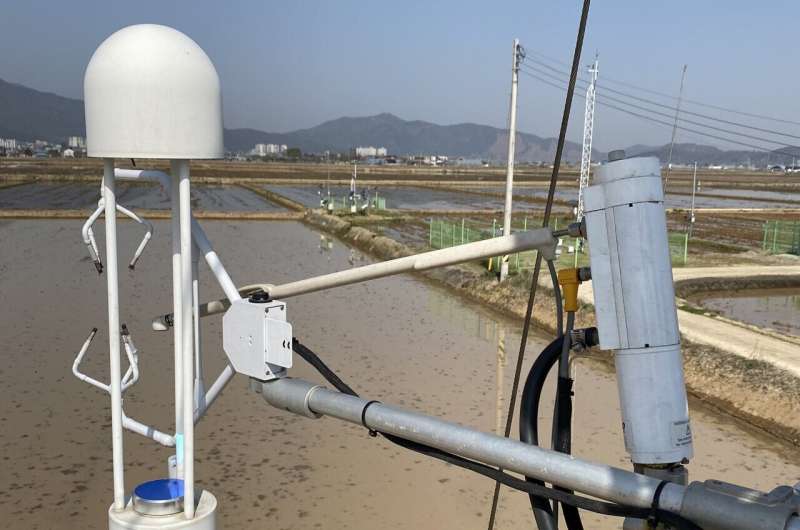New technology enhances measurement reliability of methane gas emissions from rice paddy fields

The joint research team of Dr. Namgoo Kang from the Korea Research Institute of Standards and Science (KRISS) and Dr. Minseok Kang from the National Center for Agro Meteorology (NCAM) has developed a novel technology that enhances the reliability of measurement of methane emissions from rice paddy fields. They report on their work in Agricultural and Forest Meteorology.
Methane is a greenhouse gas with 25 times the greenhouse effect per unit material compared to carbon dioxide. Since methane accounts for about 30% of greenhouse gas emissions in the domestic agriculture sector, accurate measurement of methane emissions from rice paddy soil is essential to establish effective policies in response to climate change.
The world’s most widely used method for measuring methane emissions from rice paddy soil is a chamber method. This method involves installing box-shaped chambers at regular intervals on the soil and calculating the amount of methane collected per unit area and time. However, emission levels may be distorted, as continuous monitoring is not possible, and the results are limited to the confined areas within chambers.
The eddy covariance method, which addresses the limitations of the chamber method, allows continuous measurement of methane emissions from rice paddy soil in open and wide spaces. The problem is that although the measurement results may be affected by the height of installed measurement equipment depending on soil conditions, the related research and guidelines are not enough. That’s why the chamber method is still being used to calculate country-specific emission factors for registration in the database of the United Nations Framework Convention on Climate Change (UNFCCC).
Using eddy covariance data collected from rice paddy soil in Cheorwon, Gangwon-do Province in 2020 and 2021, the KRISS-NCAM joint research team identified the difference in measurement results due to changes in observation height for the first time and proposed a method for correction.
The basis of this achievement is the technology of using methane reference gas developed by KRISS for precise calibration of both the chamber method and the eddy covariance method. This is the first research to which the internationally recognized standard was applied for measuring methane emissions from the rice paddy soil.
The results can be applied to verify the data on national greenhouse gas emissions and enhance data reliability through a mutual comparison of the chamber method and the eddy covariance method. In addition, it can contribute to improving measurement accuracy and integrating data in various greenhouse gas observation networks around the world.
Dr. Namgoo Kang, a team leader of the Measurement Instrumentation and Data Verification Research Team and a professor of Precision Measurement Major in the University of Science and Technology, said, “The eddy covariance method is a core strategic technology that will establish itself as a global standard technology supplementing the chamber method. Our results will contribute to the establishment and the implementation of plans to achieve carbon neutrality across agriculture, forestry, and livestock industries at the national level by 2050.”
The joint research team plans to continue their research, focusing on the potential of the eddy covariance method in forestry, horticultural and livestock industries. Specifically, they will develop a customized quality management technology for smart agriculture in order to enable accurate monitoring of greenhouse gases.
More information:
Minseok Kang et al, On securing continuity of eddy covariance flux time-series after changing the measurement height: Correction for flux differences due to the footprint difference, Agricultural and Forest Meteorology (2023). DOI: 10.1016/j.agrformet.2023.109339
Provided by
National Research Council of Science & Technology
Citation:
New technology enhances measurement reliability of methane gas emissions from rice paddy fields (2023, June 28)
retrieved 29 June 2023
from https://phys.org/news/2023-06-technology-reliability-methane-gas-emissions.html
This document is subject to copyright. Apart from any fair dealing for the purpose of private study or research, no
part may be reproduced without the written permission. The content is provided for information purposes only.
For all the latest Science News Click Here
For the latest news and updates, follow us on Google News.

